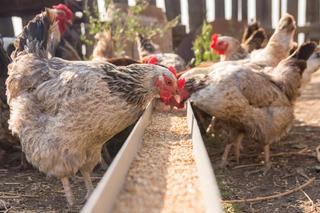Advances in Poultry Nutrition
The Science Behind Your Hen’s Dinner


Each kind of poultry is different: chickens, ducks, geese and turkeys all have special needs. The requirements differ for hens producing eggs and for growing chickens or fattening up meat birds.
Feeding poultry involves special considerations you don’t encounter when feeding other farm animals! For example, the chicken’s body processes are conducted in a shorter time. Digestion is more rapid; respiration and circulation is faster, and their body temperature is 10 degrees higher than other animals.
Basics of Poultry Nutrition
Chickens mature early and the production of eggs is always complete, or there is none! A hen doesn’t lay half an egg. A young chick increases weight 10 times or more in five or six weeks. The bottom line is that chickens are animals that require a high rate of metabolism. This is what makes feeding your poultry unique.
Another interesting fact about chickens is that more than half of their body, and their eggs, are composed of water. With this in mind, like water, each nutrient in your feed plays an important role in poultry health.
For example, protein is the most expensive part of feeding chickens and plays a significant part in overall development. It is high in amino acids, nutrients that make muscles and ligaments, and a chicken�’s body needs 22 of the essential amino acids.
Mark Eggers, innovation & technology lead, Cargill’s animal nutrition & health, North America, told Chicken Whisperer Magazine that soybean meal is a fantastic ingredient. “It is really high in protein, high in amino acids, and the vast majority of people don’t have a reaction to soy,” said Eggers.
Eggers added that at Nutrena, a leading producer of animal feed for over 100 years, they’ll use multiple different ingredients to create a complete, balanced poultry diet.
“So that means we have ingredients such as corn, oats and milo. Those are all your kinds of energy sources. Soybeans and soybean meal are really good protein sources and then you have the vitamins and minerals that balance the diet.”
The exact nutritional analysis of each poultry feed ingredient varies within its source and the time of year it was grown. The methods by which it was grown and harvested also impact the nutritional value.
The essentials when it comes to nutrients include:
Protein and amino acids: The most common source of protein in commercial rations is soybean meal.
Vitamins: Derived from plant or animal sources, vitamins are needed in small amounts for normal growth and activity. Their requirements remain fairly consistent all year.
Calcium and phosphorus: Calcium is the most important mineral in a chicken’s body and phosphorus is the next most prevalent.
Potassium: Potassium is the third most important mineral and is needed for cellular fluid balance and normal heart function. Legumes and other protein sources are potassium rich.
Salt: Commercially prepared rations contain all the salt a flock may need.
Manganese: Manganese is needed for bone and skin development.
Selenium: Selenium is an important antioxidant. Fish meal and dried brewer’s yeast are good sources of selenium.
Fat: Chickens need some fat for health and growth. Their bodies use fat to store energy and fat-soluble vitamins. Omega-6 fatty acid known as linoleic acid comes from nuts, seeds and vegetable oils.
Free-range chickens naturally seek out “high-quality” bugs, worms and other animal proteins, including feathers! However, it’s important to note that feathers are not recognized as a supplemental, specialty or value-added ingredient!
What about signs of deficiency?
Identifying any single nutrient as the cause of a particular deficiency is difficult because most nutrients have more than one function. Also, a deficiency may not result from a bird’s inability to metabolize existing nutrients. For example, an intestinal issue or disease may inhibit nutrient absorption. Most signs appear as a gradual progression, and often, it’s too late, and a hen may stop laying or even die.
Unlocking Potential With Specialty Ingredients
What other ingredients add value to your chicken’s overall diet? Herb blends, such as oregano and rosemary, are very beneficial to backyard chickens and chickens in general.
“And we are actually one of the first to include some of the herbal blends or the essential oils in our feed,” said Eggers. It’s all about gut health and the microbiome.
Eggers shared with Chicken Whisperer Magazine that Nutrena’s NatureWise line incorporates these herbal blends to enhance the gut health of backyard breeds. This approach is supported by ongoing research on the microbiome, allowing for tangible tracking of gut health improvements in chickens. Feeding grains with low digestibility results in sticky droppings. Sticky droppings moisten litter, which promotes an ideal environment for pathogens.
“We have worked for the last several years on our proprietary blend of herbs, which is a blend of oregano, rosemary, thyme, anise and then yeast. We work very hard on different combinations because more isn’t better. You do have to have the right combination, and that has given us an extremely efficient way for the birds to digest all their food, leading to healthier birds.”
Quality Ingredients and Sourcing: One Brand’s Point of View
In the dynamic world of poultry nutrition, formulating feed is as critical as the ingredients themselves. Some feed companies succinctly capture this philosophy. Unlike the traditional method, where’ locked-in formulas’ are common — particularly in the backyard poultry space — Nutrena adopts a more fluid and responsive strategy. There is a fundamental difference in how they look at ingredients.
“We don’t subscribe to locked-in formulas because ingredients change,” said Eggers. “Some people will talk about locked-in formulas in the backyard poultry space. We don’t do that. So the reason is because ingredients do change. Protein levels change throughout the year on different crops. And so we sample all those ingredients throughout the whole year.”
“And we will make minor changes within that formula. Again, minor changes, not huge swings, but we will make minor changes to balance that formula. And that is key because there are certain times of the year when you will see ingredients change in their nutrient profile. And so we are constantly adapting.”
Sustainability Practices in Feed Production
Sustainability in the feed industry is not just about producing environmentally friendly products; it’s about intelligent resource management and ensuring the long-term viability of the agricultural ecosystem.
Why overfeed a bird?
“So that’s another reason why we balance diets based on a nutrient level, not an ingredient level. We do our testing at our research farm, and we look at how much of the diet that’s fed to those birds is actually digested and then utilized to either make eggs, or put muscle on meat birds. Then we measure what’s excreted out. So, when you talk about sustainability and not wasting nutrients or feed, we definitely look at that, and that’s something that we take very seriously,” Eggers said.
Balancing nutrients appropriately is critical for optimal poultry health and productivity. The specific needs can vary depending on the poultry species (chickens, turkeys, ducks), their stage of life (growth, laying period) and purpose (meat, eggs, breeding). Therefore, it’s essential to adjust the feed formulation to meet the specific nutrient requirements of your birds.
Remember that a chicken’s energy needs also change with its level of activity. A bird that free ranges and spends a lot of time foraging requires more energy than one that gets its daily ration from a feed trough.
Tags:Chicken Chatter

Acreage Life is part of the Catalyst Communications Network publication family.















